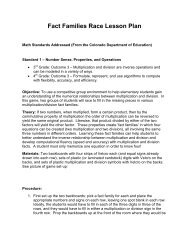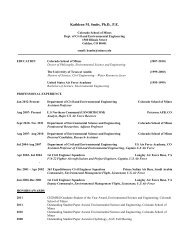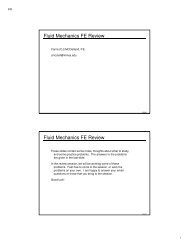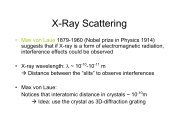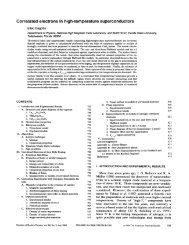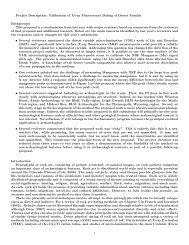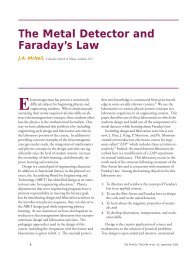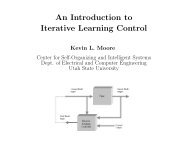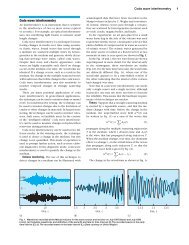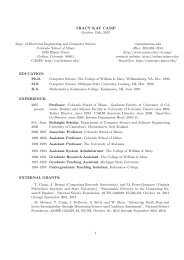Debris Basin and Deflection Berm Design for Fire-Related Debris ...
Debris Basin and Deflection Berm Design for Fire-Related Debris ...
Debris Basin and Deflection Berm Design for Fire-Related Debris ...
Create successful ePaper yourself
Turn your PDF publications into a flip-book with our unique Google optimized e-Paper software.
<strong>Debris</strong>-Flow Mitigation <strong>Design</strong><br />
<strong>and</strong> depth required <strong>for</strong> debris impact <strong>for</strong>ce equations<br />
(Eq. 5 <strong>and</strong> 6) can be estimated as presented in Table 2<br />
<strong>and</strong> discussed by Prochaska et al. (2008b).<br />
In addition to debris impact <strong>for</strong>ces, the debris<br />
barrier should also be designed to withst<strong>and</strong> boulder<br />
impact <strong>for</strong>ces. For cantilever steel members in a<br />
debris barrier, the flexural stiffness equation would be<br />
most appropriate (Hungr et al., 1984; Johnson <strong>and</strong><br />
McCuen, 1992; <strong>and</strong> Lo, 2000):<br />
p<br />
F~v b sin b<br />
ffiffiffiffiffiffiffiffiffiffiffiffi<br />
m b K B<br />
ð7aÞ<br />
K B ~<br />
3EI<br />
(YL B ) 3 <strong>for</strong> a cantilever beam or wall ð7bÞ<br />
where F 5 impact <strong>for</strong>ce (MN), v b 5 boulder velocity<br />
(m/s), b 5 acute angle between the velocity vector <strong>and</strong><br />
the barrier surface, m b 5 boulder mass (Mg), EI 5<br />
bending stiffness of barrier (GPa*m 4 ), L B 5 length or<br />
height of barrier (m), <strong>and</strong> Y 5 ratio of distance<br />
between the impact location <strong>and</strong> barrier support to<br />
the length of the barrier.<br />
The boulder velocity <strong>for</strong> use in Eq. 7 should be equal<br />
to the predicted debris-flow velocity, <strong>and</strong> the size of the<br />
design boulder should be based on the available sizes of<br />
transportable material (Hungr et al., 1984; Lo, 2000).<br />
Once the maximum impact <strong>for</strong>ce from Eq. 5, 6, <strong>and</strong> 7 is<br />
decided upon <strong>for</strong> design, this load should be increased<br />
by a factor of safety of 1.5 (Table 1).<br />
Consideration of the site-specific debris gradation<br />
can also be incorporated into the recommended barrier<br />
spacings. In Japan, barriers are typically spaced at 1.5<br />
to 2 times the size of the largest boulders (VanDine,<br />
1996; Miyazawa et al., 2003). Barrier spacings used in<br />
model tests also fall within this range (Chen <strong>and</strong> Ho,<br />
1997). This requirement could be added to the barrier<br />
spacing specifications presented previously. Channelspecific<br />
maximum particle sizes could be estimated<br />
through investigations of the sizes of material present<br />
within the channel <strong>and</strong> source areas, <strong>and</strong> also the sizes<br />
of boulders previously deposited on the fan. This<br />
evaluation of maximum particle size is also required <strong>for</strong><br />
the estimation of boulder impact <strong>for</strong>ces (Eq. 7).<br />
Outlet Works Specifications<br />
Easton et al. (1979) <strong>and</strong> L.A. County (2005)<br />
provide one st<strong>and</strong>ard outlet works design <strong>for</strong> all<br />
constructed basins, <strong>and</strong> it may be more practical to<br />
provide a few different st<strong>and</strong>ard designs from which<br />
to choose. Specifically, different designs should<br />
address the ability of the outlet works to convey<br />
different levels of flow <strong>and</strong> the resistance of the outlet<br />
tower to various magnitudes of impact <strong>for</strong>ces.<br />
Because Easton et al. (1979) specify that the debris<br />
barrier should be designed <strong>for</strong> loads from only clear<br />
water flow, it is likely that the st<strong>and</strong>ard design <strong>for</strong> the<br />
outlet tower also does not consider debris-flow<br />
impact <strong>for</strong>ces. It should be verified that the existing<br />
or any future design has an appropriate factor of<br />
safety (Table 1) against the debris impact <strong>for</strong>ces<br />
predicted by Eq. 5 <strong>and</strong> 6 <strong>and</strong> the boulder impact<br />
<strong>for</strong>ces predicted by Eq. 7.<br />
Different outlet works designs should be developed<br />
<strong>for</strong> different expected impact <strong>for</strong>ces. The<br />
existing st<strong>and</strong>ard design (L.A. County, 2005) could<br />
be used as a generic template, with specific<br />
dimensions <strong>and</strong> notes obtainable from a table based<br />
on the expected flow depth, velocity, <strong>and</strong> boulder<br />
sizes. Each design should provide a factor of safety<br />
of at least 1.5 against the expected <strong>for</strong>ces (Table 1).<br />
These different designs could also provide various<br />
flow capacities within the range of discharges<br />
observed from the region’s debris-flow-producing<br />
drainage basins.<br />
Miscellaneous Specifications<br />
An important aspect of apportioning emergency<br />
mitigation ef<strong>for</strong>ts is the likelihood of an individual<br />
basin to produce a debris flow. Cannon (2001) found<br />
that debris flows were not the prevalent response <strong>for</strong><br />
95 recently burned drainage basins in Colorado, New<br />
Mexico, <strong>and</strong> Cali<strong>for</strong>nia. Only approximately 40<br />
percent of these basins produced debris flows as their<br />
initial erosive response, <strong>and</strong> only one basin produced<br />
a debris flow in a subsequent erosional event<br />
(Cannon, 2001). Thus, in order to efficiently allocate<br />
mitigation funds, the likelihood of individual drainage<br />
basins to produce debris flows should be<br />
estimated, along with the associated hazard <strong>and</strong> risk<br />
in the event that a debris flow does occur.<br />
The U.S. Geological Survey has developed an<br />
empirical relationship to estimate the probability of<br />
fire-related debris-flow occurrence from individual<br />
basins (Cannon et al., 2003; 2004a; 2004b):<br />
P~ ex<br />
1ze x<br />
x~{29:693z10:697(%Burn){9:875(Sorting)<br />
z0:208(I)z5:729(%Organics){0:957<br />
(Permeability)z9:351(Drainage)<br />
z2:864(%GE30%){8:335(%Burn %Organics)<br />
ð8aÞ<br />
ð8bÞ<br />
z4:669(Sorting Drainage){0:174(%GE30% I)<br />
Environmental & Engineering Geoscience, Vol. XIV, No. 4, November 2008, pp. 297–313 305



